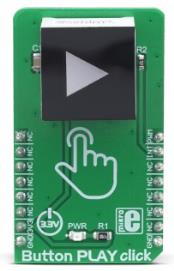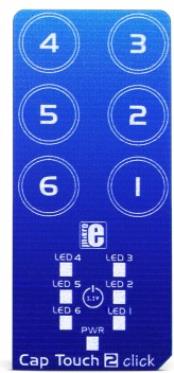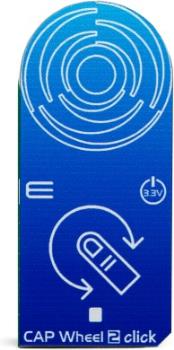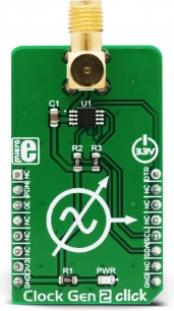Search
Search for "click":
(Click here to search this entire website for "click" with Google.)
 |

|
|
Brushless 6 click is designed to drive a three-phase sensorless, brushless motor, also known as the BLDC motor. The motor rotation is controlled by receiving driving commands via the incoming PWM signal. This click board fully controls the rotation of the BLDC motor by utilizing the onboard MCU ATmega8A, an 8-bit MCU from Microchip. The onboard MCU outputs are not adequate to power on the coils of the BLDC motor directly, so this MCU is used to control the power circuitry, instead. This circuit consists of 6 MOSFET transistors, used to switch the power from an external power source to the appropriate stator coils.
The advantages of the BLDC motors over the other types of DC motors are many. Thanks to their contactless design, BLDC motors last longer and because of the superior rotational speed and torque properties, BLDC motors are widely used for high-speed, lightweight applications such as the drive motors for drones, electronic cooling equipment, small house appliances, robotics and similar applications. The Brushless 6 click provides an easy and elegant solution for driving BLDC motors. |
|
|
|
 |

|
|
Button PLAY click is a very interesting interactive gadget on a Click board™. It is an integrated capacitive touch sensor display in the form of a button. By utilizing an advanced capacitive touch sensing technology, the CTHS15CIC05ARROW sensor can successfully replace the traditional mechanical button, allowing very simplified yet reliable user interfaces to be developed. Besides the touch detection, this sensor also features a green arrow icon with backlight, which makes the Click board™ very useful for building various stylized and visually appealing interfaces.
Button PLAY click is supported by a mikroSDK compliant library, which includes functions that simplify software development. This Click board™ comes as a fully tested product, ready to be used on a system equipped with the mikroBUS™ socket.
|
|
|
|
 |

|
|
Cap Touch 2 click is a capacitive touch sensing Click board™, with the advanced touch/proximity sensor IC, based on the proprietary RightSense® technology from Microchip. Cap Touch 2 click has six touch sensitive channels and six independent LED drivers with several operating modes, including touch sensor linking, as well as the pulsing and breathing effects. It also supports Multiple Touch Pattern Detection (MTPD), and press-and-hold function. Capacitive touch sensor inputs are protected from false detections, which can be caused by the low noise and RF interferences, providing a very reliable touch sensing functionality. |
|
|
|
 |

|
|
Cap Touch 5 Click is a capacitive touch sensing Click board™ which features the CY8CMBR3106S-LQXI CapSense® Express™ controller which enables advanced, yet easy-to-implement, capacitive touch sensing user interface solutions. It supports up to 16 capacitive sensing inputs, eliminates time-consuming firmware development. This controller is ideal for implementing capacitive buttons, sliders, and proximity sensing solutions with minimal development-cycle times.
Cap Touch 5 Click is supported by a mikroSDK compliant library, which includes functions that simplify software development. This Click board™ comes as a fully tested product, ready to be used on a system equipped with the mikroBUS™ socket.
|
|
|
|
 |

|
|
CAP Wheel 2 Click is a capacitive touch sensor with round-shaped electrodes integrated on a Click board™. This click can sense touch even through plastic, wood, or other dielectric materials, which can be used to protect the surface of the PCB and the sensor pad trace itself. Therefore, this Click board™ comes with overlay, made of plexiglass. Unlike the mechanical button, the capacitive touch button lasts much longer, it is not prone to damage and wear over time and it is very reliable. This Click board feature QS263B sensor which contains a ProxSense® module that uses patented technology to provide detection of proximity and touch conditions on numerous sensing lines.
Cap Wheel 2 click is supported by a mikroSDK compliant library, which includes functions that simplify software development. This Click board™ comes as a fully tested product, ready to be used on a system equipped with the mikroBUS™ socket.
|
|
|
|
 |

|
|
The Click USB Adapter board provides the necessary interface for connecting Click add-on boards to your PC through a high speed USB connection, without the need for a microcontroller as a mediator. It features the FT2232H dual high speed USB to multipurpose IC, an Analog-to-Digital converter, EEPROM memory and a single mikroBUS host socket. The Click USB Adapter board can only be powered via USB cable. Two jumpers are provided on board; J1 jumper is used to select whether UART or I2C will be used, and J2 selects whether the AN pin in the mikroBUS socket will be a GPIO pin, or connected to the MCP3204 AD converter circuit. |
|
|
|
 |

|
|
Clock Gen 2 click is an accurate square wave generator that can generate a clock signal in the range from 260kHz to 66.6MHz. It generates a square wave in the frequency of 66.6MHz, which is then processed by the prescaler, which can be set in the range from 2 0 up to 2 8. This allows the full frequency range to be achieved on the output. The DS1087L, a 3.3V spread-spectrum EconOscillator, used on the Clock Gen 2 click, offers the spread-spectrum function, which can be controlled via the IC pin and register setting. This allows reduced EMI, especially on the high frequencies. Finally, the DS1087L offers a NV memory (EEPROM), which is used for storing the values of the configuration registers. |
|
|
|
 |

|
|
Clock Gen 3 Click features a low power self-contained digital frequency source providing a precision frequency from 1kHz to 68MHz, set through a serial port. This Click board™, an I2C configurable clock generator, features the LTC6904 from Analog Devices and requires no external components other than a power supply bypass capacitor, and it operates over a single wide supply voltage range of 2.7V to 5.5V. The LTC6904 features a proprietary feedback loop that linearizes the relationship between digital control settings and frequency. It has many features that make it attractive for various applications such as a microcontroller clock source, clock source for a switched capacitor filter, or general replacement for a DAC/VCO combination.
Clock Gen 3 Click is supported by a mikroSDK compliant library, which includes functions that simplify software development. This Click board™ comes as a fully tested product, ready to be used on a system equipped with the mikroBUS™ socket.
|
|
|
|
 |

|
|
Clock Gen 5 Click is a compact add-on board that contains a digital programmable oscillator solution. This board features the LTC6903, a low-power self-contained digital frequency source providing a precision frequency from 1kHz to 68MHz set through a 3-wire SPI digital interface from Analog Devices. The LTC6903 features a proprietary feedback loop that linearizes the relationship between digital control setting and frequency and provides a smaller, more reliable, and vastly more versatile clocking solution. The frequency between 1kHz and 68MHz is set by a 16-bit control word, typically accurate within 1.1% with a resolution of 0.1% or better. This Click board™ is suitable for applications such as MCU clock source, clock source for a switched capacitor filter, or general replacement for a DAC/VCO combination.
Clock Gen 5 Click is supported by a mikroSDK compliant library, which includes functions that simplify software development. This Click board™ comes as a fully tested product, ready to be used on a system equipped with the mikroBUS™ socket.
|
|
|
|
 |

|
|
DC Motor 10 Click is a brushed DC motor driver with the current limiting and current sensing. It is based on the TLE 6208-6 G, an Hex-Half-Bridge / Double Six-Driver IC, optimized for motor driving applications. It can be operated SPI communication interface, allowing to drive the connected motors in three different ways: it can be used as a free configurable as switch, half-bridge or H-bridge, offering an additional speed control and direction options. The TLE 6208-6 G also contains a set of protection features, offering a very high level of reliability. Besides driving capabilities, DC Motor 10 click can also sense current consumption at its output.
DC Motor 10 click is supported by a mikroSDK compliant library, which includes functions that simplify software development. This Click board™ comes as a fully tested product, ready to be used on a system equipped with the mikroBUS™ socket.
|
|
|
|
 |
|
<< First
< Previous
Next >
|
|

